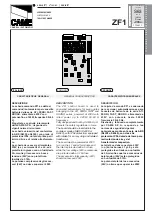
13
■EPDT-179c■
8.2 Troubleshooting (see 8.3 Exploded draiwing, Fig.4; 8.4 Troubleshooting procedure)
Problem
Presumable cause
Corrective action
1. Leakage from the stop valve on bypass
pipe.
1.
Close the stop valve. If leakage continues,
replace the stop valve.
2. External sensing pipe tube is not
connected.
2. Connect the external sensing pipe.
3. Needle valve
○
37
is clogged by foreign
materials.
3. Purge the foreign materials from needle
valve
○
37
.
4. Foreign object pinched between disc
○
10
and valve seat
○
2
.
Damage to disc and/or
valve seat.
4. Remove the foreign object from disc
○
10
and valve seat
○
2
.
Replace the disc
○
10
i
f
damaged. If the seat of valve is damaged,
consult us.
5. Loosened hexagon socket head cap
bolt
○
26
and/or locknut
○
25
5. Tighten hexagon socket head bolt
○
26
and
locknut
○
25
.
6. Damaged diaphragm
○
22
6. Replace diaphragm
○
22
.
7. Foreign object pinched between
diaphragm shell
○
19
and slide of top guide
○
8
.
7. Remove foreign object from diaphragm
shell
○
19
and slide of top guide
○
8
.
8. Foreign object pinched between spindle
○
12
and slide of bottom cover’s
○
17
guide .
8. Remove foreign object from spindle
○
12
and slide of bottom cover’s
○
17
guide
9. Loosened hexagon head nut
○
14
of valv
e
9. Tighten hexagon head bol
t
○
14
on valve
.
10. Loosened hexagon socket head cap bolt
○
9
of top guide
10. Tighten hexagon socket head cap screw
○
9
on top guide.
Ⅰ
.
Reduced
pressure exceeds
prescribed value.
(※
1
)
11. Damaged balance diaphragm
○
7
11. Replace balance diaphragm
○
7
.
12. Strainer at inlet is clogged
12. Clean the screen of the strainer.
13. Needle valve
○
37
is clogged by foreign
materials.
13. Remove foreign material from needle
valve
○
37
.
14. Foreign object pinched between
diaphragm shell
○
19
and slide of top guide
○
8
.
14. Remove foreign objects from diaphragm
shell
○
19
and slide of top guide
○
8
.
Ⅱ
.
Reduced
pressure does not
reach prescribed
value. Or, fluid
fails to flow.
15. Foreign object pinched between spindle
○
12
and slide of bottom cover’s
○
17
guide
15. Remove foreign matters from spindle
○
12
and slide of bottom cover’s
○
17
guide
16. Needle valve
○
37
is clogged by foreign
materials.
16. Remove foreign material from needle
valve
○
37
.
17. Loosened hexagon head bolt
○
18
of
bottom cover, or damaged O-ring
○
3
17. Tighten hexagon head bolt
○
18
on
bottom cover or replace O-ring
○
3
.
18. Loosened hexagon head bolt
○
28
on top
diaphragm case
18. Tighten hexagon head bolt
○
28
on top
diaphragm case
19. Loosened hexagon socket head cap
bolt
○
26
and locknut
○
25
19. Tighten hexagon socket head cap bolt
○
26
and locknut
○
25
.
20. Damaged diaphragm
○
22
20. Replace diaphragm
○
22
.
Ⅲ
.
External
leakage
21. Loosened hexagon socket head cap bolt
○
6
on the bottom diaphragm case is
loosened or O-rings
○
3
and
○
4
are
damaged
21. Tighten lower hexagon socket head cap
bolt
○
6
on the bottom diaphragm case; or
replace O-rings
○
3
and
○
4
.
※1:
100 kPa or higher outlet pressure exceeding will lead to damage of internal components. Replace the following
parts
Hexagon socket head cap bolt
○
26
,
locknut
○
25
,
washer
○
24
,
top diaphragm plate
○
23
,
diaphragm
○
22
,
bottom
diaphragm plate
○
21
,
O-ring
○
20
,
diaphragm shell
○
19
,
balance diaphragm
○
7
,
spindle
○
12
,
disc
○
10
,
valve
○
11
,
spring washer
○
13
,
hexagon nut
○
14










































